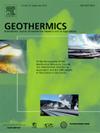Hydrogen emission characteristics of Changbaishan Volcano: Spatial and temporal distribution and genesis
IF 3.5
2区 工程技术
Q3 ENERGY & FUELS
引用次数: 0
Abstract
Active volcanoes provide conduits for deep gas migration and are potential targets for hydrogen (H2) resources. Changbaishan Volcano is one of the largest and most potentially hazardous active volcanoes in Asia, with strong volcanic gas emissions, but systematic studies on the characteristics of H2 emissions are lacking. The source and controlling factors of H2 in Changbaishan Volcano, as well as the relationship between H2 and magmatism, are still unclear. In this work, we analysed the characteristics of H2 emissions from hot springs, geothermal wells, and the soils of Changbaishan Volcano. In addition, we examined the genesis of H2 by combining He isotopes and water–rock interaction experiments. The results show that the average concentration of H2 in the hot springs is 9.5 ppm. Isotopic characterization revealed that the Changbaishan volcanic gases were emitted from the mantle and mixed with small amounts of crustal material. However, during the 2002–2005 volcanic unrest, the H2 concentration increased abruptly to 321.5 ppm, and the corresponding isotopic characterization was converted to a single magmatic genesis. These findings indicate that the hot spring H2 originated mainly from the magma chamber and was controlled by deep magmatism. The measurement results of H2 concentrations reveal that >24 % of the surveyed area has values exceed the background threshold. The average H2 concentration in the anomaly area reached 45.51 ppm, much higher than that in the hot springs and geothermal well during the volcanic quiescent period, suggesting that the soil gas was unlikely to be originated from magmatic degassing alone. Considering the widely-distributed basalts in Changbaishan Volcano, combined with the results of water–rock interaction experiments, we believe that alteration of basaltic rocks probably provides the main source for the H2 in the soil. Global comparative analyses indicate that lithology is an important factor for soil H2 emissions in volcanic areas. Volcanoes with higher soil H2 emissions are predominantly composed of mafic volcanic rocks.
长白山火山氢排放特征:时空分布与成因
活火山为深部天然气运移提供了通道,是潜在的氢气资源目标。长白山火山是亚洲最大、最具危险性的活火山之一,火山气体排放强烈,但缺乏对其H2排放特征的系统研究。长白山火山H2的来源、控制因素以及与岩浆活动的关系尚不清楚。本文对长白山火山温泉、地热井和土壤的H2排放特征进行了分析。此外,我们还结合He同位素和水岩相互作用实验对H2的成因进行了探讨。结果表明,温泉中H2的平均浓度为9.5 ppm。同位素特征表明,长白山火山气体来自地幔,并与少量地壳物质混合。然而,在2002-2005年火山不动期间,H2浓度急剧上升至321.5 ppm,相应的同位素表征转换为单一岩浆成因。这些结果表明,热液H2主要来源于岩浆房,受深部岩浆活动控制。H2浓度测量结果显示,24%的调查区域超过了背景阈值。异常区H2的平均浓度为45.51 ppm,远高于火山静止期温泉和地热井中H2的浓度,表明土壤气体不太可能仅由岩浆脱气产生。考虑到长白山火山内玄武岩分布广泛,结合水岩相互作用实验结果,认为玄武岩蚀变可能是土壤中H2的主要来源。全球对比分析表明,岩性是火山区土壤H2排放的重要因素。土壤H2排放量较高的火山主要由基性火山岩组成。
本文章由计算机程序翻译,如有差异,请以英文原文为准。
求助全文
约1分钟内获得全文
求助全文
来源期刊

Geothermics
工程技术-地球科学综合
CiteScore
7.70
自引率
15.40%
发文量
237
审稿时长
4.5 months
期刊介绍:
Geothermics is an international journal devoted to the research and development of geothermal energy. The International Board of Editors of Geothermics, which comprises specialists in the various aspects of geothermal resources, exploration and development, guarantees the balanced, comprehensive view of scientific and technological developments in this promising energy field.
It promulgates the state of the art and science of geothermal energy, its exploration and exploitation through a regular exchange of information from all parts of the world. The journal publishes articles dealing with the theory, exploration techniques and all aspects of the utilization of geothermal resources. Geothermics serves as the scientific house, or exchange medium, through which the growing community of geothermal specialists can provide and receive information.
 求助内容:
求助内容: 应助结果提醒方式:
应助结果提醒方式:


